The Tax Foundation
Improving lives through tax policy

Creating a modern online presence
The Tax Foundation engaged Fíonta to design and rebuild their website to enhance user experience, streamline content management, and create a modern, cohesive, and assertive online presence.
Challenges
- Outdated user experience and visual design
- Confusing navigation
- Disorganized data structures negatively impact SEO
- Resource-intensive, manual content curation
- Inefficient backend operations
- Cumbersome content management
Solutions
- Content Assessment
- Information Architecture
- Art Direction
- UX + UI Design
- Front End Development
- Back End Development
- Content Migration
Results
-
22%Increase in search engine impressions
-
41%Increase in search engine clicks
-
20%Increase in sitewide retention
We've been blown away by the quality of Fíonta's work product as well as the communication from the design and development teams throughout.
All of our feedback and desires were taken into account from the start of the project and the Fíonta team did a great job synthesizing everything into a website that more than delivers on our initial vision.
Project highlights
-
Modern user experience
The redesigned site is easy for visitors to navigate, discover, and engage with the Tax Foundation’s extensive research. The enhanced organization and filtering capabilities have increased user engagement, longer visit durations, and better content accessibility.
-
Dynamic page creation
The custom page builder empowers the Tax Foundation staff to create topic-focused pages with dynamic content and filters that focus on enhancing user engagement – all without developer intervention.
-
Streamlined content management
The Tax Foundation has a more efficient system for entering, organizing, and storing data, which allows for easier content creation, effectively reducing manual efforts.

Project Summary
Fíonta’s process for developing the most comprehensive solution began with an intensive discovery process that incorporated goal-setting, vision workshops, audience analysis, and in-depth content and user requirements discussions.
Building on our technical and conceptual understanding, we developed a meticulous site map and architecture that defined the website’s structure, various page types, and content hierarchy. Low and high-fidelity wireframes demonstrated the intended user experience.
Fíonta’s design phase included style tiles and design comps, which featured fonts, colors, and graphic elements aligned with the Tax Foundation’s branding identity and overarching mission and vision. We implemented a bespoke page builder so the foundation could craft dynamic pages by assembling pre-designed components, adopting a customized “low code, no code” environment to preserve design consistency.
Outcomes
The Tax Foundation has successfully implemented a streamlined content management system, significantly reducing manual data entry, organization, and storage efforts. This efficiency has enabled more effective content creation.
Additionally, dynamic page creation capabilities, supported by a custom page builder and the assertion filter plugin, allow staff to create engaging, topic-focused pages without developer intervention, resulting in a more responsive and flexible website.
Combined with a modern user experience that enhances navigation, engagement, and content accessibility, these improvements have increased user engagement, extended visit durations, and provided a more accessible repository of the Tax Foundation’s extensive research materials.




